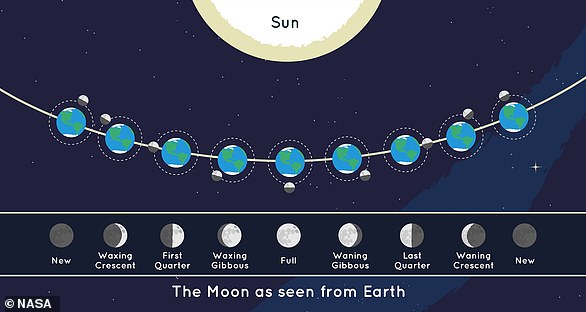Missed the supermoon? Don’t panic! Last night’s show was the first of FOUR lunar spectaculars – here are the other dates to add to your calendar
Last night, stargazers around the world were dazzled by an exceptionally rare blue supermoon.
But if you missed last night’s spectacular display, don’t panic: this is only the first of four lunar phenomena to come.
A supermoon like last night occurs when the moon reaches 90 percent of its closest point to Earth.
Luckily, these events often come in clusters, so you can see one every month from now until November.
So if you fancy admiring the starry sky, here are the key dates to mark in your diary.
Last night, the rare blue supermoon lit up the sky in a spectacular show, as seen here from Copenhagen. But if you missed it, experts say there are more opportunities to come
Because the Moon’s orbit around the Earth is not exactly circular, the distance between the two changes throughout the year.
Normally the moon is about 384,000 km long, but during a supermoon that distance is considerably shorter.
Dr Edward Bloomer, senior manager of astronomy at the Royal Observatory Greenwich, told MailOnline: ‘The changing distance between the Earth and the Moon can make the Moon appear slightly larger or smaller from the viewpoint of an observer on Earth.
‘Supermoon is not actually a precise astronomical term, but in everyday language it is a full moon that occurs at a time when the moon is within 90 percent of its minimum distance or maximum size.’
During yesterday’s supermoon, the moon was 23,000 kilometers closer than normal, almost twice the diameter of the Earth.
That difference makes the moon appear 30 percent brighter and 14 percent larger to an observer on Earth.
Last night, photographers around the world took advantage of this rare opportunity to capture stunning images of the moon.
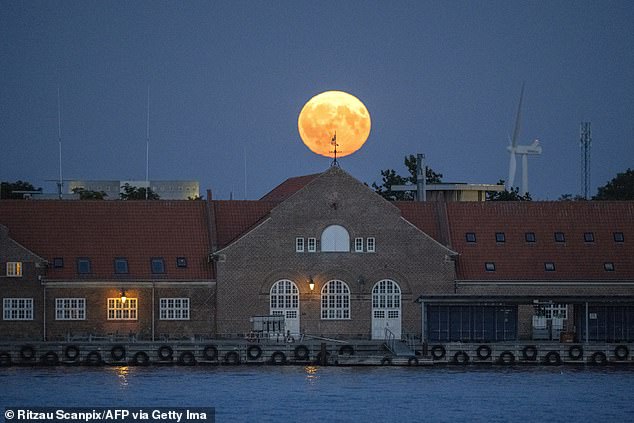
During a supermoon, the moon appears up to 30 percent brighter and 14 percent larger to an observer on Earth. Pictured is yesterday’s supermoon in Copenhagen, Denmark

Because the moon’s orbit is elliptical, its distance from Earth changes throughout the year. When the moon is within 90 percent of its closest point, it is called a supermoon.
| Name | Date and time | Distance to Earth |
|---|---|---|
| Harvest Moon | September 17, 02:34 GMT | 222,131 miles (357,486) |
| Hunter’s Moon | October 17, 11:26 GMT | 222,055 miles (357,364 km) |
| Beaver Moon | November 15, 21:29 GMT | 224,853 miles (361,867 km) |
In many of these images of the Northern Hemisphere, the Moon also appears to glow red because of smoke from North American wildfires in the upper atmosphere.
However, many keen stargazers in the UK were disappointed as thick clouds made it impossible to see anything all night.
Fortunately, there’s no reason for astronomical FOMO.
Dr. Bloomer explains that supermoons usually occur in clusters of three or four because the moon goes through its different phases in a much shorter time than the time it takes to shift its elliptical orbit.
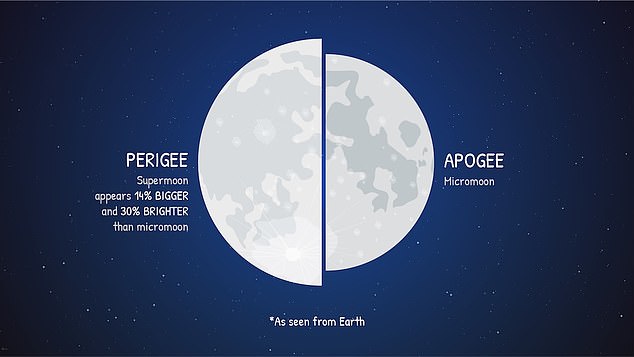
The difference is subtle, but observers on Earth can see the difference between the Moon at its closest point, or perigee, and its most distant point, or apogee
“The ‘90%’ criterion often means that we can get a few consecutive full moons that could be considered supermoons before the elliptical nature of the orbit means those full moons are too far away to count as supermoons,” Dr. Bloomer said.
‘And at the other extreme you can get a cluster of ‘micromoons,’ where the full moon occurs at a time when the Earth-moon distance is near its greatest.’
Firstly, yesterday’s supermoon will still be full for the next two days. With the improved weather forecast for England and Wales tonight, there is still time to see the blue supermoon.
The next three full moons will each be at 90 percent of the moon’s closest point to Earth, known as perigee. This means they are all considered supermoons.
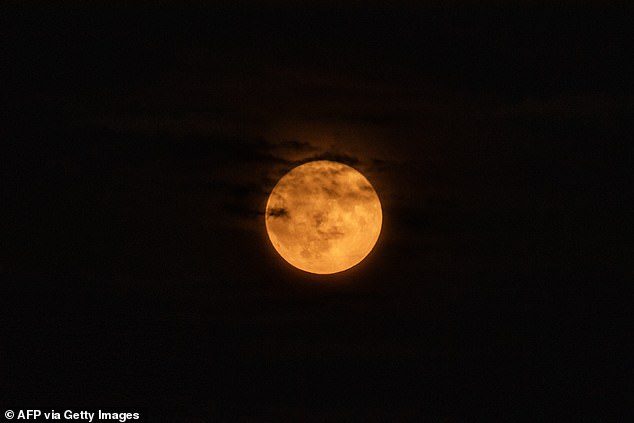
Last night’s moon also appeared red or orange to many in the Northern Hemisphere due to the buildup of wildfire smoke in the atmosphere. Pictured is the supermoon over Boston, Massachusetts
If you would like to attend these spectacular events, please mark the following dates in your diary: September 17, October 17 and November 15.
The October supermoon will be the largest of the year, as the moon will come to a distance of only 357,364 km from Earth. This is the closest the moon will come this year.
But it is September’s supermoon that promises to be one of the most spectacular.
Not only will the Moon be exceptionally close, at a distance of only 357,364 km from Earth, but the full Moon will also coincide with a partial lunar eclipse.
A lunar eclipse occurs when the Earth passes directly between the Sun and the Moon, casting a shadow across the entire lunar surface.
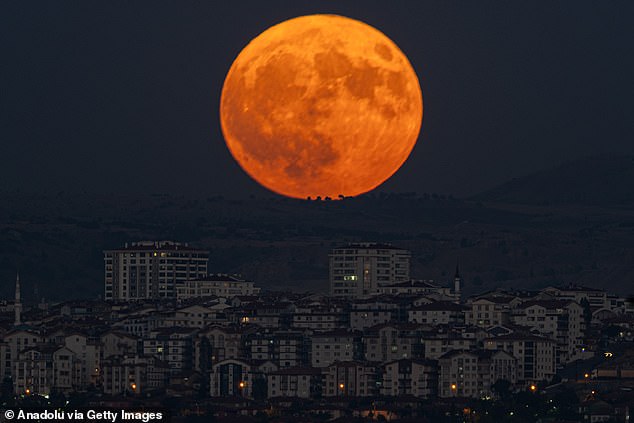
Experts say there will be three more supermoons this year in September, October and November. In the photo the supermoon over Ankara, Turkey
During a partial solar eclipse, the Moon passes through the outer edges of the Earth’s shadow in an area called the penumbra.
Small areas on the Moon can also be darkened by the Earth’s complete shadow (umbra).
During the partial solar eclipse on September 18, the maximum will occur at 03:44 (BST), with only 3.5 percent of the Moon in the umbra.
Because the moon is only partially eclipsed, it can be difficult to see the moon. So make sure you have enough time to see it clearly.
Dr Bloomer says: ‘There are loads of apps available that will tell you when and in which direction to look at the moon, so a bit of planning ahead goes a long way.

For the best view, try to capture the moon while it’s low on the horizon, like this image of the supermoon over Athens, Greece. An effect called the Moon Illusion makes the moon appear larger
“Then it’s just a matter of finding a spot nearby where the view isn’t obstructed. A nice flat horizon is great.”
Due to an effect called the moon illusion, the moon appears larger when it is close to the horizon.
If you view the moon around sunrise, you can use this phenomenon to get an even more spectacular view.
You don’t need any special equipment to see the supermoon because it’s so big and bright. However, binoculars or a small telescope will allow you to see some of the moon’s features.
Your success depends largely on clear skies, so always check the weather forecast before you set off.
Since the moon appears full for three days, it is best to choose an evening when you have the best weather.

